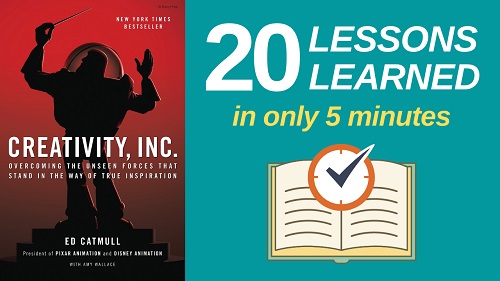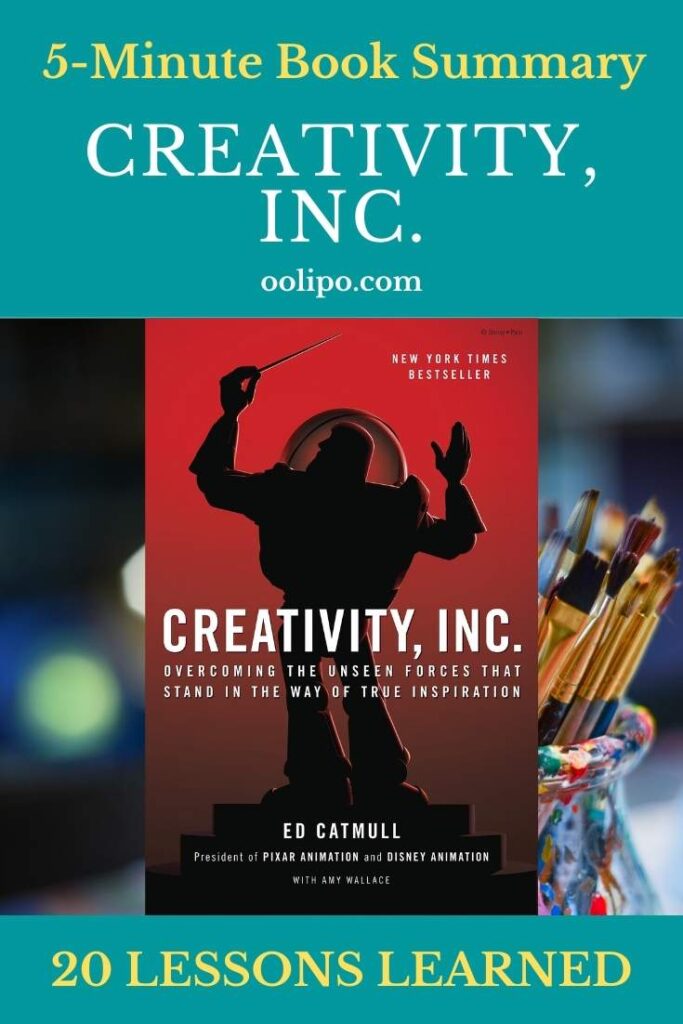Creativity, Inc: Overcoming the Unseen Forces that Stand in the Way of True Inspiration is written by Amy Wallace and Edwin Catmull. They explain how to develop the creativity you need to make a difference in business and how to achieve it together with your team. In this Creativity Inc summary, we will dive deep into Wallace’s and Catmull’s perspectives on creativity and inspiration.
Inside this book, you will find information about big companies and legendary CEOs.

Creativity Inc Summary with Lessons Learned
Here are the 20 lessons to learn from Creativity Inc Summary:
#1 Team First, Idea After
A mediocre team can waste a great idea, but a great team does great work with even a mundane idea. When buying the best for your team, do not think about any financial savings. Cheap workers steal your company’s future. To be the best, you have to work with the best.
#2 Location Matters
People cannot be creative in every environment at all hours. You should create spaces for your team where they can be creative, feel productive, and comfortable. You should ensure that they make maximum use of these areas.
#3 Individuality
You must give your team freedom regarding working hours and working environments. You cannot fill them all in identical offices and expect them to produce interesting ideas. You should also analyze the productivity of your team so that you understand how beneficial the opportunities you provide are. In this way, you can change the conditions.
#4 We All Blame
Just as success belongs to the company, failure does too. It would not be right to hold a single person responsible for failures. Because what needs to be done is your joint decision. If a wrong idea has been put forward, we are the ones who do not reject it and continue to implement it. Everyone has an equal share in success and failure.
#5 Your Priority Company
You can’t always be the one with the best idea. You shouldn’t have such a purpose anyway. You are the leader of the team. You are an employer. It is natural to have more intelligent and talented people in the team than you. Do not compete with anyone. You are on the side that sees the whole picture. In addition, small rivalries within the team do not concern you. It’s your business to solve problems anyway.
#6 Don’t Be Afraid to Criticize
If your team consists of the right people, they will try to find a solution if you are right in your criticisms, and if you are wrong, they will explain the reasons to you. Working with the right team gives you a profit in any situation. At the same time, you should appear open to criticism so that you can set an example for your team.
#7 Failure Is Normal
Don’t run from failure. Do not try to hide your failures. You found an idea. You formed a team. You tried but it didn’t work. The whole process will continue in this way until it is already successful. The part up to your first successful job is the hardest. Things work out later.
#8 Perfect Communication
No one on your team should be afraid to talk to you. They should make sure that they can reach you at any time, any second. In this way, they own the company and make more sacrifices. Don’t forget to reward them too.
#9 Encourage Your Team
No one on your team should be hesitant, especially when it comes to coming up with creative ideas. He should not be worried that if I speak my mind, I will be belittled or criticized. You should motivate everyone on your team to speak up and engage in conversation.
#10 Give Newbies a Chance
Do not underestimate those who are new to the industry or those who have not been involved in the exchange of ideas much since they started. Because you never know when and from whom the most original ideas will come. You just involve and support the conversation.
#11 Leadership
Your goal is to remove obstacles in front of your team. To provide them with the environment and motivation to work. Listen to them, solve their problems. Let them get along with themselves. You must be able to establish a good workplace environment.
#12 Problems
You will be dealing with many problems when starting a new business. When trying to solve these problems, sometimes give goofy ideas a chance. Be confident and don’t be afraid of problems. There is no insurmountable problem.
#13 Don’t Get Stuck in Your Experiences
As mentioned earlier in this Creativity Inc summary, don’t be biased, especially towards ideas that have never been tried before. If you succeed with one extraordinary idea, instead of things that have been done a thousand times, you will reach the top. You can’t get more of them if you go the way everyone else walks.
#14 Make Employees Feel Important
Whoever does what he does, from the smallest job to the biggest, in your company deserves appreciation as long as he does his job well. Do not hesitate to appreciate them and thank them for their contribution. They need to know how important they are and that they are a part of this company.
#15 You Will Have Bad Days Too
You will encounter unexpected problems not only at the beginning of the road but even at the end of the work. These are like the business. Problems that can happen to you in every project. Get together with your team for a solution and show that these types of problems can’t stop you.
#16 Decision Making
Do not act like an authority when deciding on the work to be done, the idea to be chosen. After getting everyone’s opinion with your team, analyze it and explain which idea you find appropriate. Then you can make the right decision with the feedback you get from your team.
#17 What Do You Expect?
State clearly what you expect from your team. Tell them how long and what kind of work you want to do. Guide those on your team to develop their skills. As long as they work with you, let them know that they have opportunities to improve themselves.
#18 Stress
Jobs with high expectations are also stressful. Teams that cannot handle this stress are removed from the market. The better your team communicates with each other, the lower their stress level will be. They can also manage it best in stressful situations.
#19 Being a Role Model
If you want your team to respect you, respect them too. If you want your team to be punctual, be punctual too. If you want your team to dress well, dress well. Whatever you do, you will see it in your team.
#20 You Are Not Robots
There will be times when you feel overwhelmed, bored, and want to drop everything and run away. These are the facts of life. Do not reflect the problems in your business to your family, and the problems in your family to your work. Just listen to your head. Getaway for a short while. Then continue working from where you left off to achieve your dreams.
Top 10 Quotes from Creativity Inc
1. “When it comes to creative inspiration, job titles and hierarchy are meaningless. That’s what I believe. But unwittingly, we were allowing this table—and the resulting place card ritual—to send a different message. The closer you were seated to the middle of the table, it implied, the more important—the more central—you must be.”
2. “There is nothing quite like ignorance combined with a driving need to succeed to force rapid learning. I know this from firsthand experience. In 1986, I became the president of a new hardware company whose main business was selling the PixarImage Computer.”
3. “The mantra of mass production became: Keep the assembly line going, no matter what, because that was how you kept efficiency up and costs down. Lost time meant lost money. If a particular product in the chain was faulty, you pulled it off immediately, but you always kept the line rolling. To make sure the rest of the products were okay, you relied on quality-control inspectors. Hierarchy prevailed. Only upper managers were given the authority to halt the line.”
4. “If there was one thing we prided ourselves on at Pixar, it was making sure that Pixar’s artists and technical people treated each other as equals, and I had assumed that that same mutual respect would be afforded to those who managed the productions.”
5. “Supporting your employees means encouraging them to strike a balance not merely by saying, “Be balanced!” but also by making it easier for them to achieve balance.”
6. “In many ways, it is no different than any other group of creative people—within it, you will find humility and ego, openness and generosity. It varies in size and purpose, depending on what it has been called upon to examine. But always, its most essential element is candor. This isn’t just some pie-in-the-sky idea—without the critical ingredient that is candor, there can be no trust. And without trust, creative collaboration is not possible.”
7. “Strong and confident people can intimidate their colleagues, subconsciously signaling that they aren’t interested in negative feedback or criticism that challenges their thinking. When the stakes are high and there is a sense that people in the room don’t understand a director’s project, it can feel to that director like everything they’ve worked so hard on is in jeopardy, under attack.”
8. “All directors, no matter how talented, organized, or clear of vision, become lost somewhere along the way. That creates a problem for those who seek to give helpful feedback. How do you get a director to address a problem he or she cannot see? The answer depends, of course, on the situation.”
9. “While problems in a film are fairly easy to identify, the sources of those problems are often extraordinarily difficult to assess. A mystifying plot twist or a less-than-credible change of heart in our main character is often caused by subtle, underlying issues elsewhere in the story. Think of it like a patient complaining of knee pain that stems from his fallen arches.”
10. “There’s a quick way to determine if your company has embraced the negative definition of failure. Ask yourself what happens when an error is discovered. Do people shut down and turn inward, instead of coming together to untangle the causes of problems that might be avoided going forward? Is the question being asked: Whose fault was this? If so, your culture is one that vilifies failure. Failure is difficult enough without it being compounded by the search for a scapegoat.”
Free PDF Download of Creativity Inc Summary to Save or Print
We created a PDF file with the summary and quotes on this page for easy access: Download Creativity, Inc. PDF Summary. If you want to buy the paperback version of the book, check out this page.
Animated Summary
The Popular Edwin Catmull Talk About Creativity, Inc.
Please share these important lessons by pinning this post to Pinterest.
